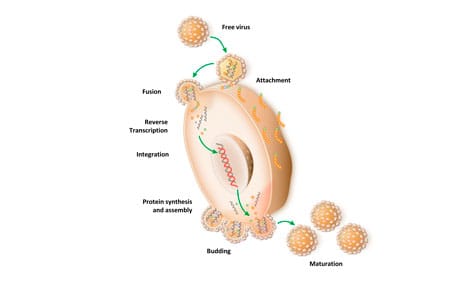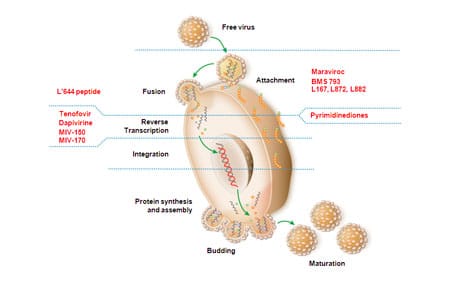How ARV-based Microbicides Work
ARV-based microbicides work by targeting HIV at different phases in its life cycle.
- Cell fusion: Preventing the virus from entering human cells
- Reverse transcription: Preventing the copying of viral RNA into DNA, which blocks the virus from integrating with the human cell or making copies of itself
The microbicide products IPM is developing do this in a variety of different ways:
Blocking the virus from entering the cell
The first steps of the HIV infection cycle, where HIV attaches to and enters the human cell, can be blocked with compounds known as entry or fusion inhibitors.
- CCR5 blockers, such as maraviroc, as well as CXCR4 blockers, are examples of these ARV drugs. They work by blocking cell receptors, called CCR5 and CXCR4, respectively, and prevent HIV from attaching to the host cell, interrupting the HIV life cycle in its earliest stages.
- gp120 inhibitors, such as DS003, bind to the gp120 proteins HIV needs to attach to healthy cells. Like CCR5 and CXCR4 blockers, gp120 inhibitors prevent the virus from attaching to and entering healthy cells.
- gp41 inhibitors can also interfere with these first steps by blocking the viral gp41 protein and therefore the ability of HIV to fuse with human immune cells.
Blocking replication of the virus
Once HIV has entered the cell, the virus continues the process to reproduce itself. Early in this phase, viral RNA is copied into DNA using an enzyme called reverse transcriptase.
This viral DNA copy would then be integrated into the host cell DNA. Various ARV drugs are known to block reverse transcription, interrupting that process.
Reverse transcriptase inhibitors come in two classes: non-nucleoside reverse transcriptase inhibitors (NNRTIs) and NRTIs (nucleotide reverse transcriptase inhibitors).
- NNRTIs work by binding to the HIV enzyme called reverse transcriptase, which is essential to the viral replication process, and therefore blocking HIV from making copies of itself. Dapivirine is an example of an NNRTI.
- NRTIs work by mimicking nucleotides that are the building blocks of viral DNA. These compounds act like a bad link in a chain. Once they are incorporated into the viral DNA, the next link cannot be added, so the viral DNA stops growing, and the reverse transcription process is blocked. Tenofovir is an example of an NRTI.
Also being researched are two additional ARV types for use as microbicides.
- Integrase inhibitors prevent the virus from permanently inserting its genetic material into human chromosomes — another way to block viral reproduction.
- Protease inhibitors, such as darunavir, prevent HIV from constructing the protein components it needs to assemble new viruses.
Learn more about IPM’s products.

